In the last decade, board games with a campaign, that adds and changes rules and components between games, and alters the world based on player choice, are becoming increasingly popular. What are the best legacy board games on the market in 2023?
Introduction to Best Legacy Board Games in 2023
There are some common points that legacy games share:
- They have a strong story, that connects individual games together. This is absolutely essential, as it is another magnet that draws you back to the game and keeps you hooked until you finish it.
- After you finish the campaign, there is usually no replay value – you are done with the game. Although it’s worth mentioning that some games allow you to reset the state or allow you to play on the finished game state just like a “regular” board game.
- Legacy board games require a large time and player commitment. For the best experience possible, you want to play the whole game with the same player group. Also with game sessions not so long apart that you would forget the rules and plot between plays.
This last point is what people usually miss – they get all those great games and then they sit on their shelf of shame unplayed or unfinished. Games are meant to be played! If you’re looking to buy a legacy game, make sure you will be able to play it regularly!
As a last note, I tried to keep this list as spoiler-free as possible. Surprise is a big feature of legacy games and reviews should not ruin that for the players. The article is written in a way that tells you what the game is about, how it plays, and what can you expect from the legacy part, without giving out anything.
Table of Contents
You can click on a title below to quickly navigate through the article.
- Risk Legacy (the first legacy game)
- Pandemic: Legacy Season 1, 2, and 0 (cooperative fight against disease)
- Gloomhaven, Gloomhaven: Jaws of the Lion, and Frosthaven (dungeon crawler)
- Charterstone (worker placement)
- The Rise of Queensdale (city-builder)
- Betrayal Legacy (horror)
- Zombie Kidz Evolution (cooperative game for young kids)
- Aeon’s End: Legacy (cooperative deck-builder, card-combat)
- Clank! Legacy: Acquisitions Incorporated (deck-builder push-your-luck adventure)
- The King’s Dilemma (political discussion)
- Conclusion (with honorable mentions and personal recommendation)
There are affiliate links by the titles. I am affiliated with Amazon (as well as with some other stores) and will earn a commission if you buy something through my link.
Risk Legacy
Designers: Rob Daviau, Chris Dupuis
Year published: 2011
Players: 3-5, best with 5
Playing time: 60 minutes
Complexity: light/medium
Theme and Setting
Risk is probably one of those board games that every gamer encounters at the beginning of his career – before he digs deeper for more advanced games.
The strategy game of world domination is around since 1957 and has reached huge popularity, well into the mainstream market.
Game Mechanics
The rules of Risk are very simple. You and your buddies (soon-to-be enemies) sit around the world map, which is divided into provinces. Each turn, you receive reinforcements depending on the number of provinces you control. (+ bonuses from continents and cards)
Then it’s time to attack other players. Only two things count in battle: the number of troops and dice. When one of the players completes his hidden goal (i.e. controlling several continents), he wins and the game ends.
Despite the simplicity, you can have a lot of fun with Risk, especially with the right people. Alliances, protection pacts, and inevitable backstabbings mixed with the uncertainty of dice rolls guarantee very exciting gameplay.
Now imagine that you play a 15-game campaign with the same people, controlling your customized faction. You can permanently customize the map (founding cities, renaming continents, adding permanent bonuses or maluses to territories, etc), destroy and add components, and make the game your own, unique experience.
At some point in the game, you will also open sealed secret packages that contain new content. I’ll try not to spoil it for you, but opening those gifts is a super-exciting part of the game. You will feel like a child at Christmas.
Games are also shorter than the regular Risk since the objectives are now much more focused and reached faster. You can play several games in the same amount of time it would take one game of regular Risk.
The Good
- A fresh approach to a classic game of Risk.
- Games are faster.
- Customization adds much-needed depth and immersion.
The Bad
- Other legacy games have since surpassed its take on the legacy mechanism.
Who should buy it?
Risk Legacy from 2011 was revolutionary as it was the first of its kind. Its legacy mechanisms have become industry-standard, but Risk Legacy still offers a good experience, especially for casual players.
Pandemic: Legacy Season 1, 2, and 0
Designers: Rob Daviau, Matt Leacock
Years published: 2015, 2017, 2020
Players: 2-4
Playing time: 60 minutes
Complexity: medium
Theme and Setting
Matt Leacock’s Pandemic from 2005 is renowned as one of the best cooperative euro games. But it was Rob Daviau’s legacy touch, that lifted the game to legendary status.
Pandemic is a game where players play as a team (they can choose the roles of Medic, Scientist, Researcher, Generalist, or Dispatcher) and fight four lethal diseases that are spreading around the globe.
Game Mechanics
The game mechanics of Pandemic are very solid and easy to comprehend. Each turn consists of three phases, with the players making their moves in the first.
On your turn, you can take 4 actions. Your options are:
- move,
- treat diseases,
- build a research station,
- cure a disease (certain conditions must be met for this one),
- or share knowledge (cards).
After your turn, you draw two new cards. Cards are used to travel faster or cure diseases if you have a completed set of them.
Then the infection phase starts. You draw cards from the infection deck, infecting more cities (adding cubes to them). If a city already has 3 cubes, an outbreak occurs, infecting all nearby cities.
Players win if they manage to cure all four diseases or lose if there are too many outbreaks, they run out of cubes or cards. This results in a very challenging co-op experience, where you’re constantly on the brink of losing. Players must use their special abilities wisely and work together.
Let’s add the legacy deck now. The deck of cards will guide you through the 12-scenario campaign. Every scenario has a special set of rules and after the game, the deck will tell you what to do with your game. (If you fail a scenario, you can replay it.)
Anything can happen and it depends on how and what you did so far: there are sealed boxes to open, the story progresses, you will permanently alter the board with stickers or writing, and many more things.
There’s always something new and exciting happening – a twist in the story, an interesting new component, or a concept. There are a lot of surprises and memorable moments. Indeed, Pandemic: Legacy is one of the most memorable board-gaming experiences.
The Seasons
Season 1 is the one that’s most similar to the original Pandemic. It’s very strong in the narrative. Although somewhat linear, the story provides a lot of twists and “wow” moments.
Season 2 takes place some 70 years after Season 1. The world is a lot different and you build it from the “inside out”. It tries a lot of experiential game mechanics and the story branches out more. The game feels different from Season 1 but is still excellent.
Season 0 is the latest addition. You’re not fighting diseases, but rather enemy agents. The year is 1962 and the Soviets are preparing a dangerous new bio-weapon, called Project Medusa.
It’s remarkable how they managed to keep the approach fresh through the 3 seasons. Although they are based on the same mechanics, the rules twists, story and other elements make each one worthy of a play, even if you experienced the others.
Which one to buy then? Although the games are independent of each other (meaning you can start anywhere), I am an advocate of starting with Season 1. I’m sure you’ll buy the other two seasons next. 🙂
The Good
- Solid game mechanics, enhanced with one of the best legacy components on the market.
- Unforgettable experience.
- A lot of legacy components create a highly customized game.
The Bad
- You have to replay the scenario if you fail the first time.
- Some issues with “quarterbacking” (players instructing others what to do)
Who should buy it?
Pandemic: Legacy is one of the best legacy board games and board games in general. I believe everyone should experience what Matt and Rob did to the legacy genre – it truly is a remarkable, unique, and highly entertaining board game series.
Gloomhaven, Gloomhaven: Jaws of the Lion, and Frosthaven
Designer: Isaac Childres
Years published: 2017, 2020
Players: 1-4
Playing time: 60-120 minutes
Complexity: medium/heavy
Theme and Setting
Gloomhaven is set in a fantasy world. You will explore it, clear the dungeons, improve your character’s abilities with experience, find, buy and sell loot, and discover the story, depending on the decisions you make.
While it may lack some of the legacy mechanics compared to let’s say Pandemic, its 95-scenario campaign is riddled with player choices, character progression, growth, and story. You’ll also unlock new stuff that comes in mysterious envelopes.
Game Mechanics
Gloomhaven is a dungeon crawler. Each of the scenarios requires you to build a map and set out enemies, treasures, doors, and other objects. Then it’s your job to explore it, clear it, escape it, or whatever the scenario demands. The legacy and story part is done between scenarios.
But it’s not like the dungeon part is a drag. Far from it, it’s arguably the best in business.
You start each scenario with a number of cards in your hand. That depends on your character. Cards determine what you can do: move, fight, loot, heal, etc.
Initiative
Each character plays 2 action cards per round and reveals them face-up. The initiative number on the cards determines the order of play. Low-initiative cards are usually weaker than high-initiative cards.
Including monsters, cards are played from the lowest initiative value to the highest. Actions are carried out immediately and are affected by combat modifier cards (you can customize this deck during the campaign in your favor).
Action cards have top and bottom actions (typically the top being for attacking and the bottom for moving) and you have to decide on one top action and one bottom action from each card.
Used cards are discarded, and you can only regain them by resting, but that means you have to give away one of the cards for good. And beware – if you run out of action cards, the scenario is over for you – you are exhausted.
Deciding what combination of cards to use, when to use them, and what is the most effective way of doing that, is the core of Gloomhaven’s gameplay, creating a giant puzzle. How do you come through a dungeon with your hand?
Combining cards is what you’ll be doing in Gloomhaven for the vast majority of the time. Fortunately, it’s an excellent game mechanic and a very enjoyable challenge, disguised in an immersive adventure.
Slay them all!
Monsters are controlled by drawing from an artificial intelligence deck of cards, so you’ll never know how exactly to approach a certain monster since it can behave differently than last time.
Gloomhaven is a gigantic game. It’s made of hundreds of components and just setting up a scenario and sorting everything to its place can be quite a daunting task.
The gameplay itself is smooth, but it’s very mentally demanding on the players. There are dozens of small rules you have to take into account, and you’ll find yourself constantly going back to the rule book for clarifications, particularly when you’re still learning the game.
Prequel and Sequel
Gloomhaven: Jaws of the Lion is a standalone prequel. It takes the best bits of Gloomhaven, simplifies setup and fiddliness, and makes itself accessible to less-hardcore players.
It’s still Gloomhaven but dialed down so that “normal” people can enjoy it as well. The reviews so far have been overwhelmingly positive and if there’s one game that could throw Gloomhaven down from BGG #1 spot, it could be Jaws of the Lion.
But things could change once again in 2023, when Frostahaven, the true sequel is bound to be widely available. We shall see.
The Good
- A long campaign is guaranteed to keep you busy for a while.
- Refined game mechanics.
- The strong feel of progression and bond with your character.
The Bad
- A lot of components and rules – setting up and playing can be fiddly.
Who should buy it?
If you’re a hardcore enthusiastic gamer that has (both physical and mental) space and time, Gloomhaven is the best available. But I don’t outright recommend buying it.
If you like the idea of Gloomhaven but are scared away by the number of components and complexity, look for Jaws of the Lion instead. This should be your starting point into the world of Gloomhaven. It’s simpler, shorter, and much cheaper.
You can still get the big box, Forgotten Circles expansion, or Frosthaven when you finish it.
Charterstone
Designer: Jamey Stegmaier
Year published: 2017
Players: 1-6, best with 6
Playing time: 45-90 minutes
Complexity: medium
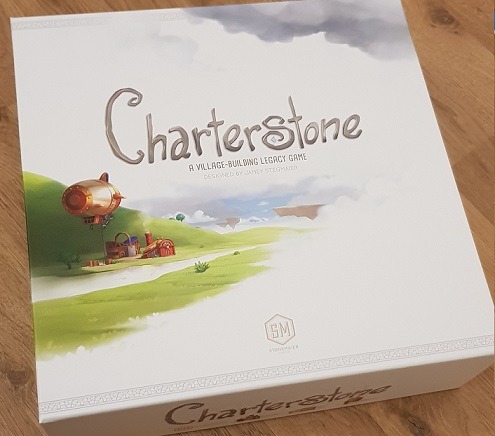

Theme and Setting
The Eternal King has authorized you and five other chiefs to colonize unexplored lands and build a new village, worthy of the King himself.
You will find yourself in front of a blank map, filled only with some general buildings, that allow you to do basic stuff, like building new buildings and discovering new stuff.
But you’re only in charge of your charter, 1/6th of the blank space. Can you develop it so that it’s the finest charter in town? And also, can you all work together in building the town, that the King will eventually love (or hate)?
Click here to read my full review of Charterstone
Game Mechanics
Charterstone is a worker-placement board game. The recipe is well-known: you place a worker on the map and reap the benefits of the tile (usually you have to pay something as well).
You can place your workers all over the map (using buildings from other players), but it’s in your charter that you have a bit more freedom and can reap greater rewards. Your overall goal through the 12-game campaign will revolve around evolving that chapter and building new buildings that will work together in synergy and reap those big points.
Each of the scenarios comes with its story cards and a general guideline for it (temporary rules). To steer you further, there are always three random goals per game, that offer more points to be earned.
There are a lot of components in Charterstone and they all come in sets of six. Six charters, six resources, six flavors of advancement cards, six helpers, and so on. This means there are a lot of things you can do and earn victory points.
Once you construct a building (peel the sticker off the card and stick it on the board), the card remains in your hand as a crate. You earn points that way and you also have the option to open the crate later on.
This yields more points and drives the game forward – introducing new components and rules. There is a lot to discover and some of the crates will surprise you and give the “wow” effect.
Each “big event”, such as a new building, open crate, goal claimed, etc. moves the Progress marker one step toward the finish, which marks the game end. This works like a clever soft cap on how much you can do in a game.
Recharge pack
As the board is two-sided, you can purchase a Recharge pack and play the campaign all over again.
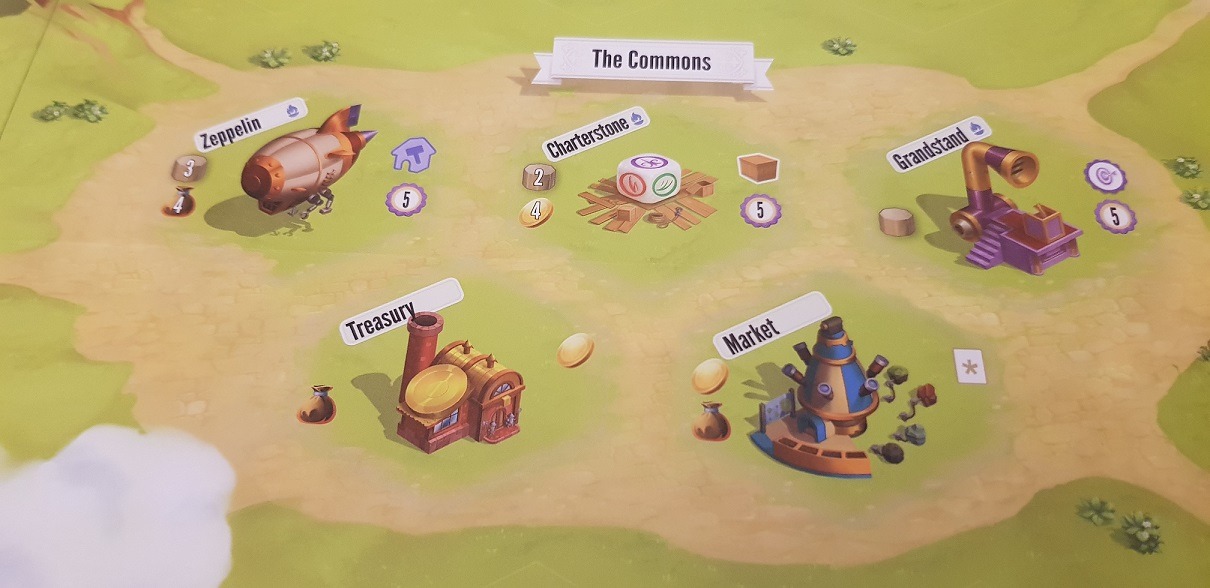

The Good
- A unique combination of worker-placement and legacy concepts.
- Top-notch components, especially wooden resources and metal coins.
- Colorful art.
The Bad
- Doesn’t play well with less than four players – six is ideal.
Who should buy it?
The gameplay is smooth and engaging and there is a lot of excitement when opening those crates. Rules are accessible (although it can feel overwhelming to introduce too many of them at once).
The campaign does a good job of holding everything together and you can feel the story progressing. The story is okay, but nothing to write home about.
For the best experience, you want to play the entire campaign with the same players and with as many of them.
The Rise of Queensdale
Designers: Inka Brand, Markus Brand
Year published: 2018
Players: 2-4, best with 4
Playing time: 45-60 minutes
Complexity: medium
Theme and Setting
Those Kings and their wishes … What is it this time? You want me to build a city for you? Oh, it’s for your Queen this time. All right then …
The Rise of Queensdale puts you in front of a map, split into four districts. These lands will start out highly undeveloped, but no worries, you will soon cultivate them.
Game Mechanics
The Rise of Queensdale is a city-building game, where your action selection is dictated by dice. The campaign lasts around 20 games, depending on when the first player wins (reaches an epoch) nine games.
You win a game by being the first to reach a certain number of victory points. You do that by completing certain valuable in-game activities (building buildings, building huts to gather more herbs, or advancing on the glory track).
Each consecutive epoch is harder to reach, meaning there is no fear of one player winning every game and the campaign ending after just nine games. That keeps the game nicely balanced and provides a catch-up mechanic, which is, in a competitive legacy game, crucial for players having fun.
Players decide on what to do based on the roll of their five dice. They will roll them for every round of the game. Dice will show either one of four resources or a special action (from the main board). If you roll wood, you can place your worker on the wood tiles and so on.
The dice dictate your moves, but you can always pay a resource to re-roll a die. Moreover, they can be customized with stickers during the campaign. I’d say the dice mechanic in The Rise of Queensdale is done excellently. It’s not completely luck-dependant, but it plays a role.
The narrative is good, but it’s not what will drive you forward. Fresh rules, goals, and components will keep you interested and the game does a good job of dosing new stuff in.
The games go fast (some games can only last 3 rounds) and you can stack several of them into an evening. The art is gorgeous and the components are good. You will especially remember the plunger which is used to take out the hexagons when building new tiles.
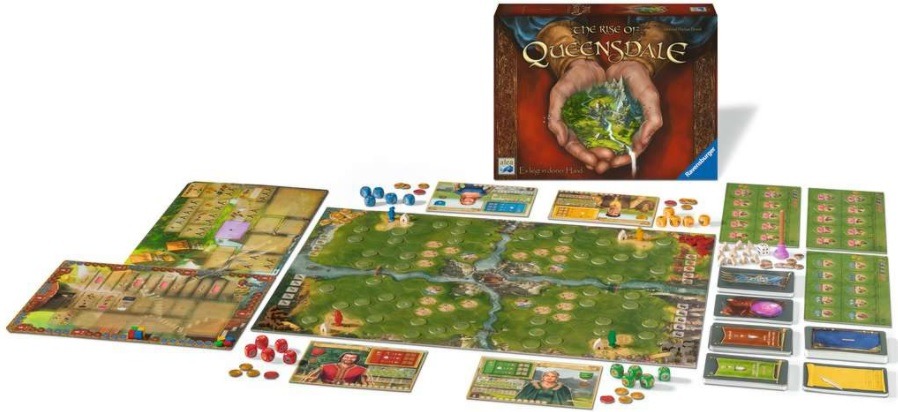

The Good
- Interesting dice action selection.
- Luck mitigation mechanics.
- Games are fast and smooth.
- Engaging story and campaign.
The Bad
- You need the same four players for the optimal experience.
Who should buy it?
The Rise of Queensdale is an excellent city-building legacy game. It’s in ways similar to Charterstone, yet it features some unique mechanics, that are worth experiencing.
As an overall fun experience, the games are neck-and-neck. Decide between them based on the number of players in your group. They both work optimally with their maximum player count and the gaming experience suffers, the more players you remove.
Betrayal Legacy
Designers: Rob Daviau and others
Year published: 2018
Players: 3-5, best with 5
Playing time: 45-90 minutes
Complexity: medium
Betrayal at House on the Hill
Betrayal Legacy is based on Betrayal at House on the Hill, a semi-cooperative horror game from 2004. You can read more about it in my Best Horror Games article. But we’ll recap the rules below also.
You and other players play as investigators that arrived at a strange unexplored house. You will explore it by adding new tiles, discovering and using items, and special Omen cards. This is the first phase of the game.
After an Omen card is picked, there is a test-roll, to see whether the second phase starts. The more Omen cards are collected higher the probability.
The second phase is the betrayal of one of the players. The betraying player is determined by several parameters (tiles, items, cards) and this is described in the instructions. These parameters also decide the type of Haunt scenario and setting. There are different scenarios, so don’t expect any two games to be the same.
What usually happens is that the betraying player gets additional powers and can summon monsters, with which he fights other players, either to kill them or to gain possession of an item they obtain. In tactical combat, players fight him, try to defeat him, and stop him from achieving his goals.
Betrayal Legacy
Instead of focusing on a single character, each player will choose a family (each with its own traits), which he will follow for 14 generations (the game is 14 scenarios long) or from 1666 to 2004. You don’t have to play every scenario with a new family member – you can age and reuse existing ones.
The Legacy deck is what drives the campaign. The cards are sorted in order and tell you what to do before and after a chapter. It also holds the conditions that trigger the Haunts and tells you when to reach for the Bleak Journal (which contains instructions for the Haunts) or when to add or remove game content.
The deck works great. You don’t have to read any extensive rulebooks, you just go card-by-card. It sets up every chapter, provides the narrative, and makes the whole experience smooth as butter.
The Bleak Journal further expands the story, especially around the Haunts. It explains the betrayal in a believable way that makes sense with the overall plot.
There are Heirloom items you can discover that stay in your family’s possession. After you’re done with the campaign, you can play the game like a classic Betrayal.
The Betrayal Legacy, unfortunately, suffers from the same two issues as the original. A lot is down to dice. Not just the Haunt, entire combat is dice-based and they have a large effect on the outcome.
The second issue is the Haunts themselves. They are a bit hit-or-miss. Some of them are epic, but there are others that leave a lot to be desired. But when pieces fall into place, the game is amazing.
The Good
- The Legacy deck helps the campaign run smoothly.
- Strong theme and narrative.
- Exciting Haunts.
The Bad
- Luck plays a part.
- Some Haunts are better than others.
Who should buy it?
Despite some issues, Betrayal Legacy is a very fun experience. The game runs smoothly, the narrative ties the chapters nicely together, and the Haunts are (overall) an exciting twist that adds uncertainty and curiosity.
If your group is looking for a horror legacy game and you don’t mind dice, Betrayal Legacy will be a great experience.
Zombie Kidz Evolution
Designer: Annick Lobet
Year published: 2018
Players: 2-4, best with 3-4
Playing time: 15 minutes
Complexity: light
Theme and Setting
The zombie apocalypse is here! You’re stuck in school with your friends and zombies are pouring in from all directions.
Can you get rid of them with your fancy weapons like a squirt gun and lock all four entries before they overwhelm you?
Game Mechanics
Zombie Kidz Evolution is a very simple cooperative game. On your turn, you first roll a die that selects which one of the five rooms receives another zombie. If you roll a blank, no zombies are added.
Then you perform your Move. If you move into a room with one or two zombies, you will clear that room. If you and one other player move to the gates, you will put a lock on them.
But beware – if a third zombie is added to a room it becomes impassable and you can no longer clear it. That means you have to take the long route. But there are only 8 zombie tokens – if they are all on the map and you have to add another, you lose!
After the game, you will receive stickers, that you will stick to your progress chart, depending on how well you did. The games are finished super-fast and you can stuff several of them in an hour if you want.
When you collect enough stickers, you will eventually unlock one of the envelopes (there are 13) that contain new gameplay components. I won’t go too much into spoiler territory – imagine things like new hero powers, stronger zombies, extra challenges to earn more stickers, and so on.
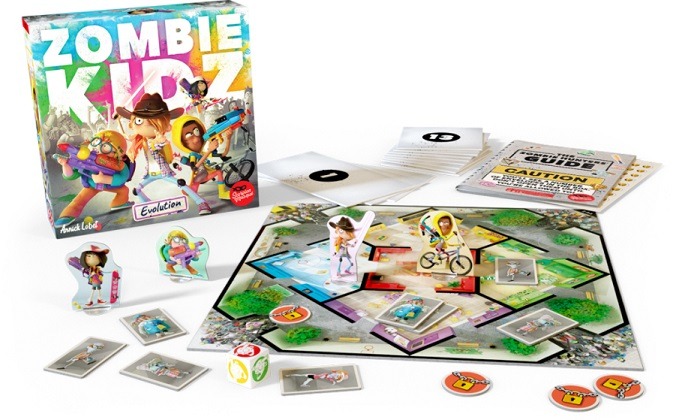

The Good
- Simple rules.
- Feeling of progression and reward.
- Playful theme.
The Bad
- Too simple for advanced players.
Who should buy it?
The simplicity of rules, games that end quickly, and the constant feeling of progression make this an excellent game for younger kids. The box says 7+, but if you play with them, I would even go as low as 5.
Read the full Zombie Kidz Evolution Review
There is just enough cooperative component that forces them to think about the bigger picture. And there are stickers as rewards. And we all know kids love stickers!
Aeon’s End: Legacy
Designers: Nick Little (I), Kevin Riley
Year published: 2019
Players: 1-4, best with 2
Playing time: 45-90 minutes
Complexity: medium
Theme and Setting
The city of Gravehold is in danger. The Nemeses (that is the plural form of Nemesis FYI) are pouring through the Breach and it’s up to you and your fellow Breach Mages to stop them and their minions.
The Legacy edition adds the progression of Nemeses, the customization of Breach Mages, the narrative, and the evolving rules and components.
Game Mechanics
Aeon’s End is a cooperative deck-builder card game. Each player chooses a character with which he will play through the campaign.
The Mages start out with a basic deck and are somewhat weak. Then, by adding new spells, abilities, and items to your deck, you will improve your character mats, get progressively stronger, and be able to chain some impressive skills toward the end.
There are a lot of customization options and you’ll only use a small portion of what’s available, discarding the alternatives. This already tells you there are different paths on how you can build your Breach Mage. Taking synergetic abilities really pays off, and you can even help out your co-players with some abilities (and vice-versa)!
The card combat starts out simple, but you will unlock new components and rules as you go along, making this edition an excellent game for introducing players into Aeon’s End. You never feel overwhelmed.
The deck-building aspect is the most impressive mechanic in Aeon’s End. When discarding cards, you have to plan ahead in which order you will place them, because the discard deck is not shuffled afterward! You just turn it around and draft cards in the order you prepared them.
Together with the Breach mechanics (you have to prepare each spell before you use it), this makes for some interesting strategic decisions. You can plan your powerful spells in advance, together with your fellow players.
But it’s not all straightforward. The turn order cards are shuffled, so you never know if you will go before or after the Nemesis.
The Nemeses each comes with its deck and you never know what monster or spell will it throw toward you. You can even fight the same Nemesis in multiple scenarios and it will be stronger and have more powers later on!
Legacy part
The story and the evolvement of the campaign are driven forward by the Legacy deck. It will tell you a bit of narrative, how to set up a scenario and which Nemesis to face. After the battle (whether you win or lose), you will find out how that affects the campaign and how to alter the game moving onwards.
What really drives the game forward is the progression of your Mages and constantly evolving rules, that deepen the experience with each scenario.
After you finish the campaign (10-20 hours of gameplay, depending on player count), you will have your fully developed Breach Mage (or a couple of them), with which you can play the game to your liking.
The Good
- A great feeling of character progression with many options.
- Deck-building mechanics are one of the best in business.
- Good cooperative experience, but also plays well in solo mode.
The Bad
- Little end-of-campaign replay incentive.
Who should buy it?
The main incentive to buy Aeon’s End: Legacy is the character progression and the ability to customize it to your liking. The card-combat and deck-building are very good, but if you don’t care much about character-building, you’re better off buying a standard Aeon’s End.
Clank! Legacy: Acquisitions Incorporated
Designers: Andy Clautice, Paul Dennen
Year published: 2019
Players: 2-4, best with 4
Playing time: 90-120 minutes
Complexity: medium
Theme and Setting
The Clank! franchise is a very popular push-your-luck deck-builder. You play as fantasy characters, whose task is to get into a dungeon (or an overworld/space equivalent of it), retrieve one or more treasures, and come back out alive. You are a thief, to be more precise.
What you can do in a turn is determined by a deck of cards, which you enhance during the game. The push-your-luck element is implemented as Clank!, the noise you generate. The longer it takes you to complete your task, the more noise you produce, and the more likely it is that you won’t make it out alive (i.e. the dragon will incinerate you).
Each of the Clank! games uses a different theme. This time it’s Acquisitions Incorporated. If you’re not familiar with it, it’s one of the D&D worlds. But you don’t need any of that knowledge to play Clank! Legacy, since the story is more than enough to cover all the details for you.
Game Mechanics
After you select a character, the first of the ten scenarios will start. The main goal remains the same – to retrieve an artifact from below the ground and get back safely. You can pick gold, items, and cards on the way, to make the journey and future scenarios easier.
The game is competitive and cooperative at the same time. You want to be the one to win a scenario, but you don’t want other players to die or do particularly badly either. There is a bigger plot behind you as you compete against Dran Enterprises.
You start each scenario with a deck of 10 cards out of which you draw 5 to your hand. The symbols on them then tell what you can do. If you want to move, you need boot symbols, to fight you need sword symbols, and so on. Many locations require a combination of symbols.
Some cards also have clank symbols, creating noise. When playing those, you must place a certain number of cubes in your color into a bag and when the dragon rages, a certain number of cubes is pulled out. Players then suffer damage to their health according to colors pulled out.
On top of that, Clank! Legacy introduces contracts and events. These are scenario-specific tasks you can do and get rewarded immediately. They are strongly supported by the narrative and a bit of reading is a common occurrence on a player’s turn.
Fortunately, the story and writing are very good. It’s thematic and filled with humor that compliments the overall playful art style excellently. But the story and legacy components roughly double the playtime of each scenario (compared to the standard edition), so that’s something to take into account.
The main game mechanic is deck-building. More cards (the initial deck more than doubles) will be introduced as the campaign goes on and some will be destroyed. You start each scenario with a deck of ten cards, but you will be able to add new cards to your deck during a scenario, thus modifying it to your needs and liking.
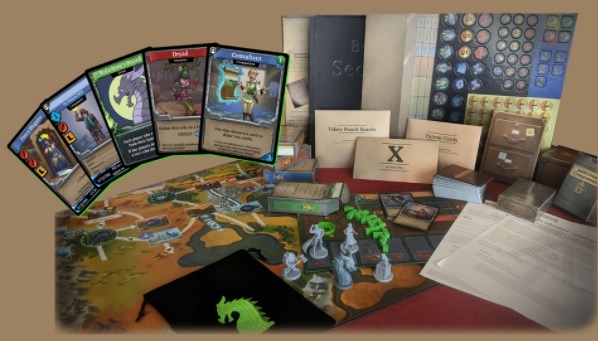

Expansion
Clank! Legacy: Acquisitions Incorporated – Upper Management Pack is an expansion that works with both the original Clank! and Clank! Legacy. It introduces four new characters, together with miniatures and decks.
The Good
- A strong story, theme, art, and component quality.
- Refined dosing of legacy elements.
- Deck-building.
The Bad
- A lot of reading stretches playing time.
Who should buy it?
It shows that Clank! Legacy: Acquisitions Incorporated has studied previous legacy titles in detail. It takes everything they did right, rectifies the wrongs, and wraps it with delicious presentation and gameplay.
Fairly accessible, works well with player counts 2-4, it’s rightfully one of the best legacy board games. I would recommend it to everybody.
The King’s Dilemma
Designers: Hjalmar Hach, Lorenzo Silva
Year published: 2019
Players: 3-5, best with 5
Playing time: 45-60 minutes
Complexity: light/medium
Theme and Setting
The success of Game of Thrones has inspired many board games and perhaps King’s Dilemma is the one that best grasps the political mind games that are held behind the facade of a court.
King’s Dilemma is set in the fictional kingdom of Ankist, where 12 Houses compete over political power. Each player (the game shines with 5 players) will pick one and will stick with it for the entire campaign that can last for generations of kings (around 20 games).
Game Mechanics
The game is not really about game mechanics. They are simple and are a sound foundation for the rest of the game. Let’s recap them quickly before we go to the important part.
The kingdom is depicted by markers for stability, influence, wealth, morale, welfare, and knowledge. In each game, the players will draft Secret agenda cards, that determine in which direction these markers should move in order to make points for them.
So, each house will have different interests in different areas. But the draft is not completely random, so you can affect slightly on which agenda card you get so that it matches your overall alignment of the kingdom’s stability.
Stability is the main marker. The game ends if it’s too high or too low, but during the campaign, your decisions will eventually make you pick a side. Either you’ll want to see the kingdom succeed or crumble.
Dilemmas and Voting
Now comes the fun part, the dilemmas. In each round, the current leader will draw a dilemma card. These are the core of the gameplay. They are really interesting moral choices, ranging from war crimes to feasts.
Now it’s time to vote. Players use their political power tokens to Aye, Nay, or Pass. Taking into account their agendas and personal beliefs, the discussion and disputes will inevitably start. You’ll find yourself advocating for things that are totally wrong, just because they will bring you some wealth points, that you so desperately need to win.
Convincing other players to vote like you want them can be done by bribing within-game or out-game. King’s Dilemma is politics at its best (or worse). No moral restraints, everything from lying to backstabbing works.
After the voting, the Dilemma is read out and resolved. Markers are moved in the right direction, the story moves on and perhaps a mysterious new envelope is opened.
Captivating
The narrative is very engaging and it’s just the right amount of text. With all the possible dilemma decisions and closed envelopes, the story branches out a lot and no two campaigns will be the same.
If the time counter is filled with cards (or the stability counter reached either end), the game ends, agenda cards are revealed and players receive their campaign points.
If you did well, you get Prestige points, if you didn’t, you get Crave points. If you get Crave points on a regular basis, you’ll be more interested to see the kingdom crumble in the future, further affecting your already hard voting decisions.
This innovative, experimental nature is also a small let-down of King’s Dilemma. There are so many aspects to look after, that sometimes you’re not really sure what you’re doing or if what you’re doing is going to drive the campaign in the direction that you want.
It also depends on the players you play with. There are strong role-playing and debate components involved that require the players to identify themselves in the roles of the house leaders and to immerse themselves in the dilemmas.
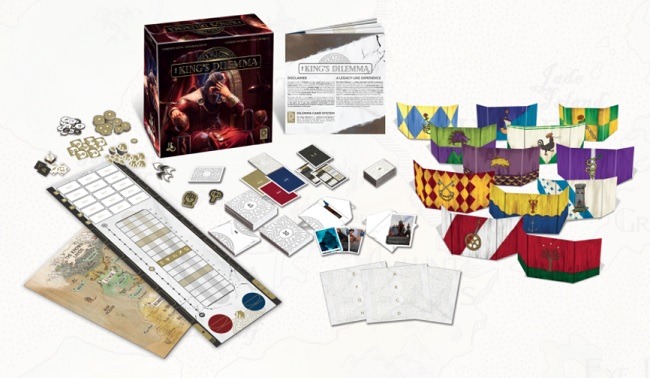

The Good
- Engaging, branching story.
- Interesting dilemmas that spur discussion and require hard decisions.
- Very simple rules.
The Bad
- Requires at least four constant, right-minded players.
Who should buy it?
If you enjoy role-playing, pre-electoral debates, and have a few similarly minded friends, King’s Dilemma provides a unique experience that will remain in your memory for a long time.
Conclusion
There are a few more legacy games out there that just didn’t make the cut for different reasons:
- SeaFall, because it’s just not a good game.
- Machi Koro Legacy, because others do things better. It would make the top 12, though.
- First Martians: Adventures on the Red Planet is a mediocre game that does not live up to its predecessor, Robinson Crusoe, Adventures on the Cursed Island
- Ultimate Werewolf Legacy was just left out of the top 10.
- We can say the same about Shadowrun: Crossfire, although that one also lacks some of the legacy elements.
So, which ones out of the Top 10, do I recommend then? I recommend all of them, taking into account you’re fine with some of the drawbacks, especially when it comes to the required player count.
But there are some that are universally great, no matter how or who with you play them, and they are:
- At Number 3: Clank! Legacy: Acquisitions Incorporated,
- at Number 2: Gloomhaven: Jaws of the Lion,
- and our Number 1, the Best legacy board game is Pandemic: Legacy (all seasons).
If you can get only one legacy board game, get this one.
- If you’re more into one-sitting strategy games, click here for Top 10 Strategy Board Games for Adults
- Top 10 Christmas Board Games – Gift Buying Guide
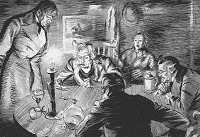

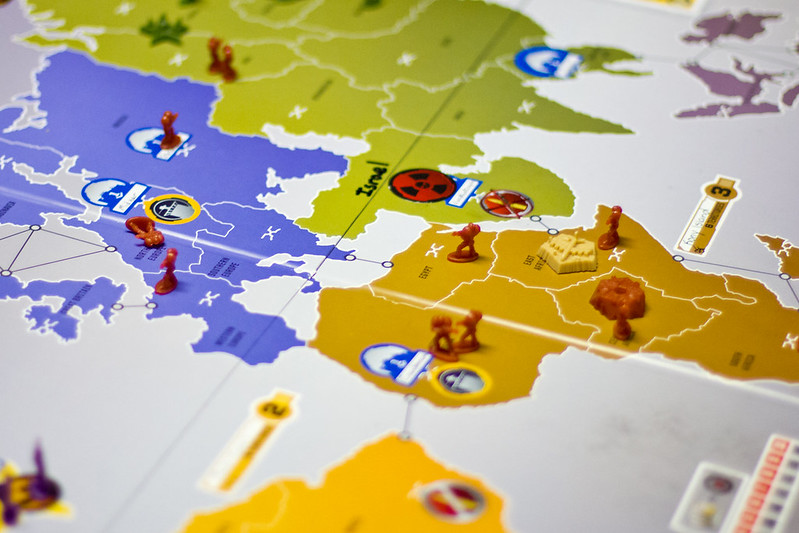













I will disagree with your mention that Seafall is a bad game. Is it unbalanced, sure- I will certainly be one to argue (without providing specific spoilers) that certain actions are most definitely- in the long run- more advantageous than other actions. And, the story is mostly event-driven with very little story-based narrative. My biggest gripe with the game is some of the rules or instructions can be ambiguously worded. And, the ending could have used a bit more of a nuanced, focused touch. There is also another event mid-way through that game that really limits the actions that players can take, which was thematic but dragged the game down.
I am aware that these handful of flaws would turn many away from the game and sour one’s experience with the game. But, I don’t think it makes it a bad game. My group thoroughly enjoyed it. When we finished our game/s for the night, each of us left for home scheming our plans for the following session.
The mechanics are really sound, and throughout the game the group is presented with puzzles, riddles, and intrigue. The game is an inconsistently pleasurable experience, but one of my most memorable ones.
I wish they would consider re-releasing the game with some revisions (especially with the wording of some rules and instruction). Perhaps, it would then make it clearer to everyone that Seafall is far from a “bad” game.
It’s definitely worse than those that made it to the list. Does that make it bad or not? I guess it’s just a matter of semantics.
I’m glad that your group enjoyed it, but try to look at it from another perspective. From the perspective of an average person, who has a limited time to play: 2, maybe three scenarios per week, after the kids go to bed and all other chores are finished.
I’m just the person in this situation and I know it takes a really long time for us to finish a legacy game. Would I really want to dedicate my time to a game that I know in advance has many flaws? No, so I choose my games carefully and pick those that I know will guarantee me a good time and with this in mind, I recommend games to others.
With the volume of games released these days, there’s no need to play just “average” games. On the other hand, if you have all the time in the world and are running out of games to play, sure, try whatever you want. I just don’t think an average player is likely to reach this level.